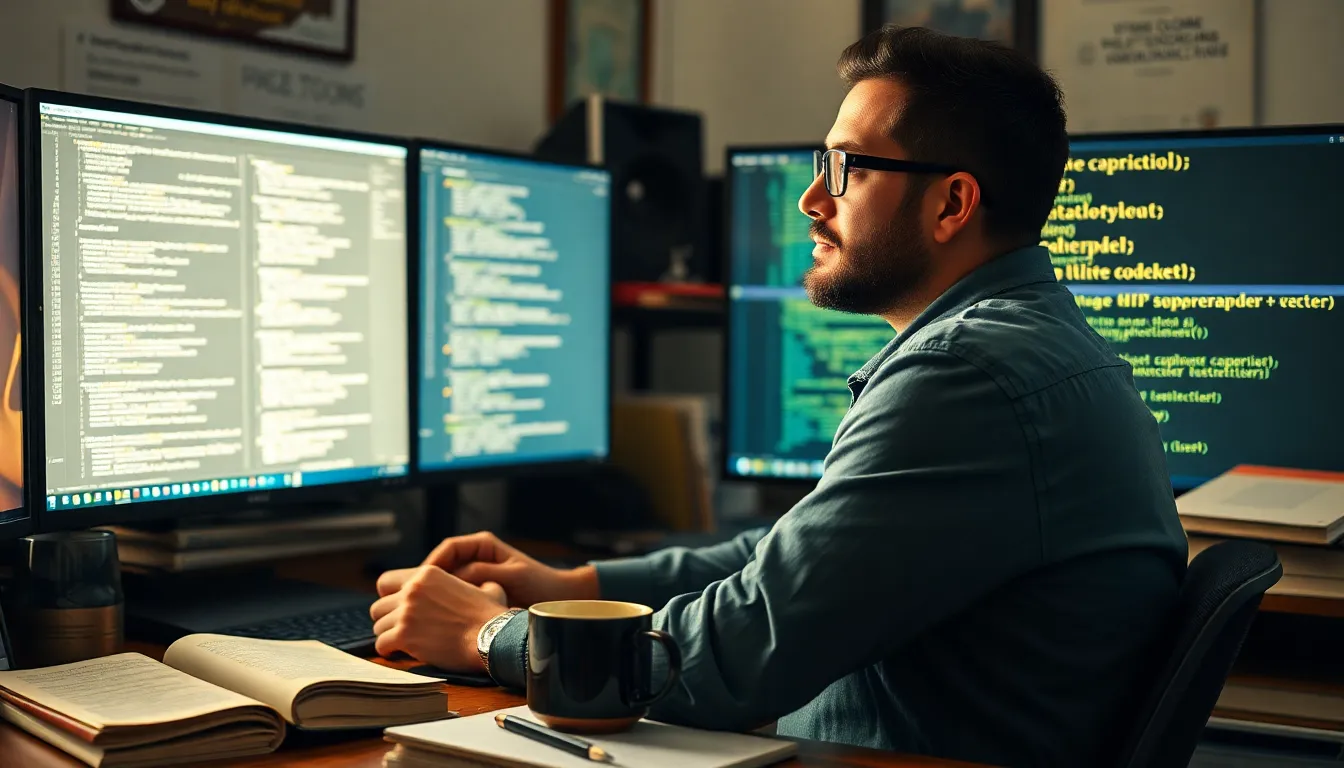In the wild world of coding, few things are as frustrating as a pesky bug in your Python code. Enter “llusyep”—a term that might sound like a spell from a wizarding world but is really just a headache waiting to happen. If you’ve ever found yourself staring at your screen, wondering why your code refuses to cooperate, you’re not alone.
Table of Contents
ToggleUnderstanding Llusyep Python Fix Code
Llusyep represents the frustration many developers feel when dealing with bugs in Python code. Fixing these bugs is crucial for maintaining functional and efficient programs.
What Is Llusyep?
Llusyep refers to the confusion and annoyance developers experience while troubleshooting code issues. It symbolizes the unexpected behaviors that arise during programming. Bugs can emerge from simple syntax errors or complex logic problems. Developers encounter these challenges regularly. Understanding the root cause of these issues aids in preventing future occurrences. Identifying distinct patterns within the flaws enhances problem-solving abilities.
Importance of Fixing Code
Fixing code is essential for improving software reliability and performance. Unresolved bugs can lead to crashes or data loss. Prioritizing code fixes enhances user experience, ensuring applications run smoothly. Higher quality code reduces maintenance costs and time. Developers who address issues promptly often experience fewer problems in the long run. Efficiently fixing code contributes to overall project success, leading to satisfied users and lower turnover rates. Ultimately, focusing on bug resolution strengthens coding skills and deepens software comprehension.
Common Issues in Llusyep Python Code

Common issues often arise during Python programming, creating complications for developers. Syntax errors and runtime errors frequently represent significant hurdles.
Syntax Errors
Syntax errors occur when code does not conform to Python’s grammatical rules. Missing colons, unmatched parentheses, or incorrect indentation often cause these issues. Such errors prevent the Python interpreter from executing code, halting the process entirely. Correcting these errors demands careful inspection of code, ensuring that each line adheres to proper syntax. For example, a simple oversight like leaving out a colon at the end of a function definition leads to immediate failures. Identifying syntax errors early minimizes frustration and streamlines the debugging process.
Runtime Errors
Runtime errors happen during the execution of a program, disrupting its flow without prior warnings. These errors can stem from various issues, such as dividing by zero or referencing undefined variables. Debugging runtime errors often involves examining variable values and ensuring they align with expected types. For instance, attempting to access an index that exceeds the length of a list results in an index error, causing a program crash. Understanding where and why runtime errors occur enhances a developer’s ability to craft resilient code and improve overall software reliability.
Step-by-Step Guide to Fix Llusyep Python Code
Fixing Python code can be straightforward when following a structured approach. Steps must focus on identifying problems, applying fixes, and thoroughly testing the code.
Identifying the Problem
Recognizing issues in Python code starts with reviewing error messages. Syntax errors surface during the initial code inspection; missing colons or inconsistent indentation highlight typical problems. Runtime errors need different attention since they appear during execution, often without clear indicators. Debugging tools assist by providing insights into where the code fails, enabling developers to trace back and understand the root causes. Examining logs can also offer critical context, revealing unexpected variables or faulty operations that disrupt program flow.
Applying Fixes
Implementing fixes in the code requires precision and clarity. Begin by correcting syntax errors, ensuring every statement adheres to Python’s rules. Switching to debugging tools proves beneficial; they can suggest corrections for common pitfalls. Runtime errors require identifying and addressing underlying issues like dividing by zero or dereferencing undefined variables. Refactoring code to improve structure often enhances readability and maintainability. Engaging in pair programming or code reviews fosters collaborative problem-solving, allowing team members to share insights and best practices, making it easier to correct errors effectively.
Testing the Code
Verifying the fixed code is crucial for stability. Unit tests directly evaluate individual components, ensuring functionality remains intact. Running integration tests helps compare the code’s interactions with other modules, highlighting new issues that may arise. Utilizing automated testing frameworks proves invaluable; they streamline the process of repeatedly testing code to confirm all parts operate as expected. After implementing changes, regression testing verifies that existing functionalities remain unaffected. Consistent testing practices assure quality and reliability, ultimately resulting in a more robust and user-friendly program.
Best Practices for Llusyep Python Coding
Emphasizing good practices in Python coding leads to improved software quality. Developers can enhance their coding experience by following established techniques.
Writing Clean Code
Clean code ensures readability and maintainability. Prioritizing descriptive variable names helps others understand purpose. Consistent formatting improves visual clarity. Commenting on complex logic clarifies intentions and aids future developers. Structuring code into functions organizes logic into manageable pieces. Adhering to the PEP 8 style guide promotes uniformity, reducing friction when revisiting code. Committing to simplicity, developers minimize unnecessary complexity, resulting in more efficient and easier-to-debug code.
Debugging Techniques
Effective debugging techniques minimize confusion during troubleshooting. Using print statements helps track variable states and logic flow. Python’s built-in debugger, pdb, provides an interactive environment for examining code execution. Strategically isolating and testing code sections narrows down error origins. Writing unit tests enables developers to identify issues proactively. Leveraging logging captures runtime information, facilitating issue tracking without interrupting program execution. Collaborating with peers during debugging sessions offers fresh perspectives. These techniques collectively enhance problem-solving skills, leading to more resilient code.
Addressing the challenges of Python programming is essential for any developer. By tackling issues like syntax and runtime errors head-on, they can enhance their coding skills and create more reliable software. The structured approach to debugging and fixing code not only resolves immediate problems but also fosters a deeper understanding of programming concepts.
Implementing best practices like writing clean code and utilizing effective debugging techniques will lead to improved software quality. As developers navigate the complexities of Python, embracing collaboration and thorough testing can significantly elevate their projects. Ultimately, overcoming the frustrations symbolized by “llusyep” paves the way for greater success in coding endeavors.







